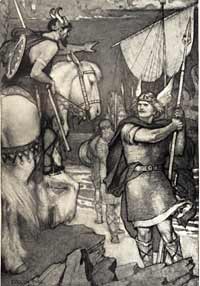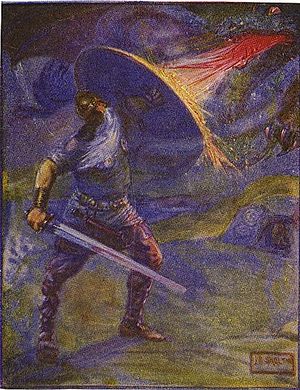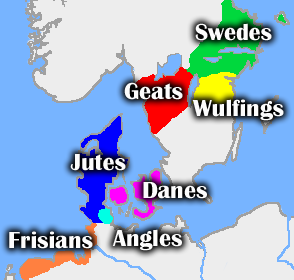بيوولف
| بيوولف Beowulf | |
|---|---|
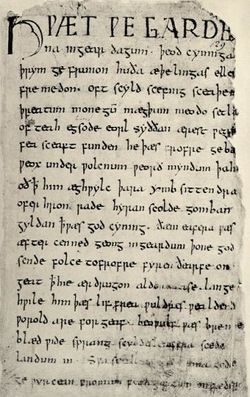 الصفحة الأولى من قصيدة بيوولف في Cotton Vitellius A. xv | |
| المؤلِف | Unknown |
| اللغة | بالإنگليزية القديمة |
| التاريخ | غير معروف، ما بين القرن 8 و11 |
| حالة التواجد | مخطوطة لحقها التلف في حريق 1731 |
| المخطوط(ات) | Cotton Vitellius A. xv |
| أول نسخة مطبوعة | ثوركلين (1815) |
| الصنف | شعر ملحمي سردي |
| صيغة النص | Alliterative verse |
| الطول | ح. 3186 سطر |
| الموضوع | معارك وبطولات بيوولف، في شبابه وكبره |
| الوضع المحيط | الدنمارك والسويد |
| الشخصيات | تشمل بيوولف, Hygelac, هرنگار، Wealhtheow, Hrothulf, Æschere, Unferth, گرندل، والدة گرندل، وگلاف ، Hildeburh. |
بـِىْيووُلف (إنگليزية: Beowulf، /[invalid input: 'icon']ˈbeɪ.[invalid input: 'ɵ']wʊlf/; in بالإنگليزية القديمة [ˈbeːo̯wʊlf] أو [ˈbeːəwʊlf])، هو عنوان تقليدي[note 1] اتفق عليه الباحثون المعاصرون لقصيدة ملحمية بطولية بالإنگليزية القديمة، تتكون من 3182 بيت، بالإسكانديناڤية، وتعتبر من أهم أعمال الأدب الأنگلو-ساكسوني.
وقصيدة بيوولف، من أطول القصائد الأنگلو-سكسونية وأنبلها قد، أنشئت في القرن السابع أو الثامن، واحتفظ بها لنا مخطوط يرجع تاريخه إلى عام 1000 يوجد الآن في المتحف البريطاني. ويبدو أن أبياتها البالغ عددها 3183 بيتاً هي القصيدة بأكملها والشعر غير مقفى ولكنه موزون متجانسة أوائل ألفاظه، مصوغ في لهجة سكسونيا الغربية لا نستطيع أن نفهمها في هذه الأيام.
ملخص القصة
والقصة نفسها كأنها عبث الأطفال، وخلاصتها أن بيولف أمير الگيات Geats في جنوبي السويد يعبر البحر ليطلق سراح هروثگار Hrothgar ملك الدنمارك من الوحش گرندل Grendel؛ وبعد أن يغلب جرندل وأم جرندل نفسها، يعود بطريق البحر إلا قيطلاند ويحكمها حكماً عادلاً مدة خمسين عاماً. ويظهر وقتئذ تنين ثالث يقذف باللهب ويعيث فساداً في أرض القيط، فيهاجمه بيولف، ويصاب في هذا الهجوم بجرح مميت، فيخف صديقه وگلاف إلى معونته ويتعاونان على قتل التنين. ويموت بيولف من أثر جرحه، وتحرق جثته على كومة الحريق. وليست القصة من السذاجة كما تبدو لنا من روايتنا هذه؛ فالتنين الذي تتحدث عنه آداب العصور الوسطى يمثل الحيوان البري الذي يكمن في الغابات المحيطة بمدن أوربا، وفي وسعنا أن نعفو عن خيال الناس الذين صور لهم الفزع هذه الوحوش في تلك الصورة الخرافية، ولقد نسجوا حولها كثيراً من الأقاصيص يعبرون بها عن شكرهم للرجال الذين تغلبوا على هذه الوحوش حتى أمنت القرى والنجوع شرهم.[1]
وبعض فقرات القصيدة مسيحية الصبغة لا تنسجم مع بقية أجزائها، كأنما أراد ناشر رحيم من الرهبان أن يحفظ هذه القصيدة الوثنية الرائعة بأن يضيع في أجزاء متفرقة منها سطراً يشعر بالتقي والصلاح. غير أن جو القصيدة وحوادثها جو وثني خالص وحوادث وثنية خالصة. ولقد كان الحب، والحياة، والمعارك الحربية على الأرض هي التي تعني بها أولئك "النساء الحسان والرجال البواسل"، ولم يكونوا يعنون بجنة هادئة وراء القبور. ويقول المؤلف في بداية القصيدة بعد أن يدفن سلد الملك الدنمرقي كما يدفن قراصنة الشمال في قارب يدفع إلى البحر وهو خال من الملاحين: "لا يستطيع الناس أن يقولوا وهم واثقون من الذي تلقى هذا العبء". غير أن جو القصيدة ليس بالجو الوثني المرح، بل تسري فيها من أولها إلى آخرها روح نكدة، وأكثر من هذا أن تلك الروح نفسها لا تبرح الحفلة التي أقيمت في بهو هرثجار. وفي وسعنا أن نلمح ثنايا أبيات القصيدة المتدفقة وما فيها من طرب وتحسر أنين العازف على القيثار:
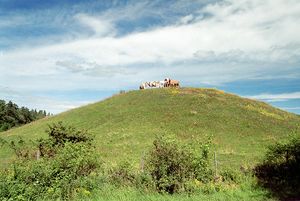
ثم جلس بيولف على مقعد بجوار البئر... وأخذ يتحدث عن جرحه، وعما يحس به من آلام شديدة أشرف من جرّائها على الموت؛ وأدرك أن منيته قد دنت... ثم طاف حول كومة الدفن رجال أبطال أقران حرب، يريدون أن يعبروا عن أحزانهم، وأن يرثوا الملك، وأن ينشدوا ويتحدثوا عن الرجل؛ فأخذوا يشيدون بكل ما أوتوا من قوة ببطولته في أثناء حياته، ويمتدحون أعماله الباسلة الجديدة... ويقولون إنه كان أعظم ملوك العالم رأفة ورحمة، وأرقهم في معاملة شعبه، وأحرصهم على كسب الثناء... ومن أجل هذا كان خليقاً بالإنسان أن يثني على سيده وصديقه... وأن يحبه بكل قلبه، إذا ما حان أجله، وفارقت روحه جسده، وغادر هذا العالم.
وأكبر الظن أن بيولف أقدم ما بقي لدينا من القصائد في أدب بريطانيا
خلفية تاريخية
مخطوطة بيوولف
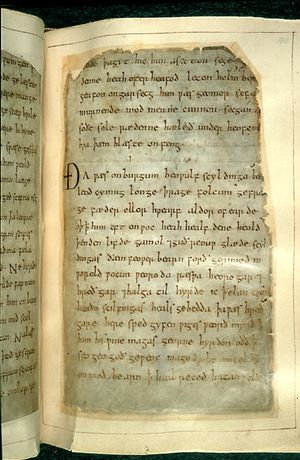
لم يتبق من بيوولف سوى مخطوطة واحدة تعود لأواخر القرن العاشر أو أوائل القرن الحادي عشر. المخطوطة بأبعاد 195 x 130 مم.
عينة - من المخطوطة الأصلية
Hwæt wē Gār-Dena in geār-dagum
þēod-cyninga þrym gefrūnon
hū ðā æþelingas ellen fremedon
Oft Scyld Scēfing sceaþena þrēatum
monegum mægþum meodo-setla oftēah
egsian eorl syððan ǣrest weorþan
Hwæt [what!] wē Gār-Dena [Spear-Danes] in geār-dagum [days of yore]
þēod-cyninga [ملك الشعب] þrym [power] gefrūnon [hear of],
hū [how] ðā æþelingas [أمير، بطل] ellen [deeds of valour] fremedon accomplish,
Oft [often] Scyld Scēfing [name: Danish dynasty of the Scyldings] sceaþena [enemy] þrēatum [troop],
monegum [many] mægþum [الأمة] meodo-setla [mead-bench] oftēah [take away];
egsian [terrify] eorl [warrior] syððan [after] ǣrest [first] weorþan [become]
تصويرات فنية
انظر أيضاً
الهوامش
- ^ "Like most Old English poems, Beowulf has no title in the unique manuscript in which it survives (British Library, Cotton Vitellius A.xv, which was copied round the year 1000 AD), but modern scholars agree in naming it after the hero whose life is its subject." (Robinson)
المراجع
قواميس
- Cameron, Angus, et al. Dictionary of Old English (Microfiche). Toronto: Published for the Dictionary of Old English Project Centre for Medieval Studies University of Toronto by the Pontifical Institute of Medieval Studies, 1986/1994.
نصوص
نصوص على الإنترنت:
- Facsimile (1882) of the 18th century autotypes of the cotton MS Vitellius A XV
- Klaeber, Frederick, ed. Beowulf and the Fight at Finnsburg. Third ed. Boston: Heath, 1950.
- McMaster University. Beowulf in hypertext.
ترجمات للإنگليزية المعاصرة:
- Alexander, Michael. Beowulf : A Verse Translation. Penguin Classics;. Rev. ed. London: New York, 2003.
- Anderson, Sarah M., Alan Sullivan, and Timothy Murphy. Beowulf. A Longman Cultural Edition;. New York: Pearson/Longman, 2004.
- Crossley-Holland, Kevin; Mitchell, Bruce. Beowulf: A New Translation. London: Macmillan, 1968
- Donaldson, E. Talbot, and Nicholas Howe. Beowulf : A Prose Translation : Backgrounds and Contexts, Criticism. A Norton Critical Edition. 2nd ed. New York: Norton, 2002.
- Garmonsway, George Norman, et al. Beowulf and Its Analogues. (Revised 1980). ed. London: Dent, 1980.
- Gordon, R.K.. The Song of Beowulf:Translation into English prose. New York, 1922. ISBN 978-0-486-27264-1
- Gummere, Francis Barton (1855-1919). 'Beowulf'. St Petersburg, Florida:Red and Black Publishers, 2007. ISBN 978-0-9791813-1-3. (Translation originally published in 1909.)
- Heaney, Seamus. Beowulf: A New Verse Translation. New York: W.W. Norton, 2001. ISBN 0-393-32097-9
- Hudson, Marc. Beowulf. Introduction and notes by Martin Garrett. Ware: Wordsworth Classics, 2007.
- Lehmann, Ruth. Beowulf : An Imitative Translation. 1st ed. Austin: University of Texas Press, 1988.
- Liuzza, R. M. Beowulf: A New Verse Translation. Orchard Park, NY: Broadview Press, 2000.
- Osborn, Marijane. Annotated List of Beowulf Translations.
- Ringler, Dick. Beowulf: A New Translation For Oral Delivery. Hackett Publishing Company, Inc., 2007. ISBN 978-0-87220-893-3; also available online, Beowulf: A New Translation For Oral Delivery.
- Raffel, Burton. Beowulf: A New Translation with an Introduction by Burton Raffel, afterword by Robert P. Creed New York: Mentor/New American Library, 1963.
- Rebsamen, Frederick R. Beowulf : A Verse Translation. 1st ed. New York, NY: Icon Editions, 1991.
- Swanton, Michael (ed.). Beowulf (Manchester Medieval Studies). Manchester: University, 1997.
- Szobody, Michelle L. & Justin Gerard (Illustrator) Beowulf, Book I: Grendel the Ghastly. Greenville, SC: Portland Studios, 2007. ISBN 978-0-9797183-0-4
- Wright, David. Beowulf. Panther Books, 1970. ISBN 0-586-03279-7
بالإنگليزية القديمة والمعاصرة:
- I. Chickering, Howell D. Beowulf: a dual-language edition.New York: Anchor books ed., 1977,1989, 2006 ISBN 0-385-06213-3
- Fulk, R.D. The Beowulf Manuscript: Complete Texts and The Fight at Finnsburgh. Cambridge, Massachusetts: Harvard University Press, 2010. ISBN 978-0-674-05295-6. Dumbarton Oaks Medieval Library 3.
- Heaney, Seamus. Beowulf: A New Verse Translation. New York: W.W. Norton, 2001. ISBN 0-393-32097-9
بالإنگليزية مع مسرد مصطلحات:
- Alexander, Michael. Beowulf: A Glossed Text. Second ed. Penguin: London, 2000.
- Jack, George. Beowulf : A Student Edition. Oxford University Press: New York, 1997.
- Klaeber, Frederick, ed. Beowulf and the Fight at Finnsburg. Third ed. Boston: Heath, 1950.
- Mitchell, Bruce, et al. Beowulf: An Edition with Relevant Shorter Texts. Oxford, UK: Malden Ma., 1998.
- Porter, John. Beowulf: text and translation. Anglo-Saxon Books, 1991.
- Wrenn, C.L., ed. Beowulf with the Finnesburg Fragment. 3rd ed. London: Harrap, 1973.
سمعيات
- Ringler, Dick & Norman Gilliland. Beowulf: The Complete Story—A Drama. Madison, WI: NEMO Productions, 2006. ISBN ISBN 0-9715093-2-8
- Baker, P. Readings from Beowulf. In Old English.
منح دراسية
- M.H. Abrams and Stephen Greenblatt. Norton Anthology of English Literature: The Middle Ages (Vol 1), Beowulf. New York: W.W. Norton, 2000. 29–32.
- Alfano, Christine. "The Issue of Feminine Monstrosity: A Re-evaluation of Grendel's Mother." Comitatus 23 (1992): 1–16.
- Anderson, Sarah. Ed. Introduction and historical/cultural contexts. Longman Cultural Edition, 2004. ISBN 0-321-10720-9
- Battaglia, Frank. "The Germanic Earth Goddess in Beowulf." Mankind Quarterly 31.4 (Summer 1991): 415–46.
- Chadwick, Nora K. "The Monsters and Beowulf." The Anglo-Saxons: Studies in Some Aspects of Their History. Ed. Peter ed Clemoes. London: Bowes & Bowes, 1959. 171–203.
- Carruthers, Leo. "Rewriting Genres: Beowulf as Epic Romance", in Palimpsests and the Literary Imagination of Medieval England, eds. Leo Carruthers, Raeleen Chai-Elsholz, Tatjana Silec. New York: Palgrave, 2011. 139–55.
- Chance, Jane. "The Structural Unity of Beowulf: The Problem of Grendel's Mother." New Readings on Women in Old English Literature. Eds. Helen Damico and Alexandra Hennessey Olsen. Bloomington: Indiana University Press, 1990. 248–61.
- Creed, Robert P. Reconstructing the Rhythm of Beowulf.
- Damico, Helen. Beowulf's Wealhtheow and the Valkyrie Tradition. Madison, Wis.: University of Wisconsin Press, 1984.
- Drout, Michael. Beowulf and the Critics.
- Gillam, Doreen M. "The Use of the Term 'Aeglaeca' in Beowulf at Lines 893 and 2592." Studia Germanica Gandensia 3 (1961): 145–69.
- The Heroic Age, Issue 5. "Anthropological and Cultural Approaches to Beowulf." Summer/Autumn 2001.
- Horner, Shari. The Discourse of Enclosure: Representing Women in Old English Literature. New York: SUNY Press, 2001.
- Jensen, S.R. Beowulf and the Swedish Dragon (Sydney, 1993): available online.
- —— Beowulf and the Monsters (Sydney, corr. edn 1998): extracts available online.
- —— Beowulf and the Battle-beasts of Yore, with illustrations by Derek Allen (Sydney, 2004): available online.
- Nicholson, Lewis E. (Ed.). An Anthology of Beowulf Criticism. (1963), Notre Dame: University of Notre Dame Press. ISBN 0-268-00006-9
- North, Richard. Origins of Beowulf: From Vergil to Wiglaf. Oxford: Oxford University Press, 2006.
- Orchard, Andy. A Critical Companion to Beowulf. Cambridge: D.S. Brewer, 2003.
- ——. Pride and Prodigies: Studies in the Monsters of the Beowulf-Manuscript. Toronto: University of Toronto Press, 2003.
- Owen-Crocker, Gale (2000). The Four Funerals in Beowulf: And the Structure of the Poem. New York: Manchester University Press.
- Robinson, Fred C. The Cambridge Companion to Beowulf (2001). Cambridge: Cambridge University Press. 143.
- Stanley, E.G. "Did Beowulf Commit 'Feaxfeng' against Grendel's Mother." Notes and Queries 23 (1976): 339–40.
- Tolkien, J.R.R.. Beowulf: The Monsters and the Critics (1983). London: George Allen & Unwin. ISBN 0-04-809019-0
- Trask, Richard M. "Preface to the Poems: Beowulf and Judith: Epic Companions." Beowulf and Judith : Two Heroes. Lanham, Md.: University Press of America, 1998. 11–14.
- Waterhouse, Ruth. "Beowulf as Palimpsest", in Monster theory: reading culture, ed. Jeffrey Jerome Cohen. University of Minnesota Press, 1996. 26-39.
- Lerer, Seth. "Dragging the Monster from the Closet: Beowulf and the English Literary Tradition." http://ragazine.cc/2012/01/beowulf-seth-lerer/
الهامش
- ^ ديورانت, ول; ديورانت, أرييل. قصة الحضارة. ترجمة بقيادة زكي نجيب محمود.
- ^ Ewald, Gustav (1950). "Är Skalunda hög kung Beowulfs grav?". Västgöta-Bygden (in Swedish). 1: 335–336.
{{cite journal}}: CS1 maint: unrecognized language (link)(Om *Birger Nermans och °Carl Otto Fasts idéer angående hednatima kungars gravplats.) - ^ خطأ استشهاد: وسم
<ref>غير صحيح؛ لا نص تم توفيره للمراجع المسماةklingmark - ^ خطأ استشهاد: وسم
<ref>غير صحيح؛ لا نص تم توفيره للمراجع المسماةNerman - ^ الصفحات 2-3 من بيوولف: نص منقح، التحرير والهوامش لميشيل ألكسندر، الكتاب منشور في عام 2005.
وصلات خارجية
- انظر hypertext editions above.
- Original manuscript: facsimile (1882) of the 18th century autotypes of the cotton MS Vitellius A XV
- Beowulf manuscript in The British Library's Online Gallery
- Beowulf on Steorarume ("Beowulf in Cyberspace"), heorot.dk
- Comparison of various English translations
- Beowulf Translated from the Heyne-Socin Text
- Articles containing إنگليزية-language text
- Pages using Lang-xx templates
- Ill-formatted IPAc-en transclusions
- Articles with hatnote templates targeting a nonexistent page
- Pages with empty portal template
- أسطورة بيوولف
- وثنية أنگلو-ساكسونية
- فلكلور إنگليزي
- أساطير بطولية إنگليزية
- قصائد ملحمية بالإنگليزية
- Geats
- تاريخ الشعوب الجرمانية
- أساطير العصور الوسطى
- فلكلور نوردي
- أعمال لمؤلف غير معروف
